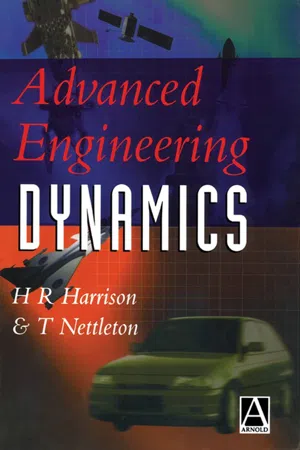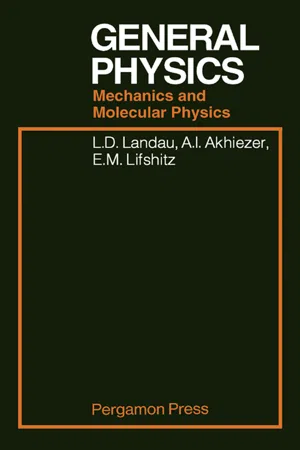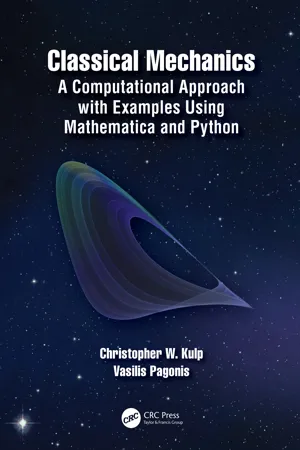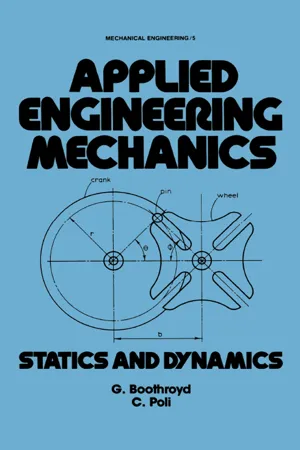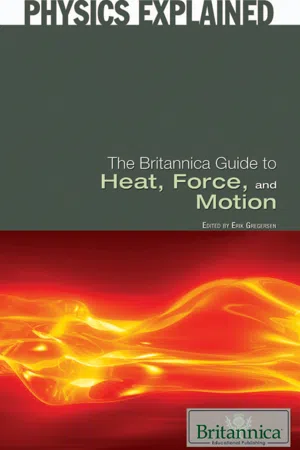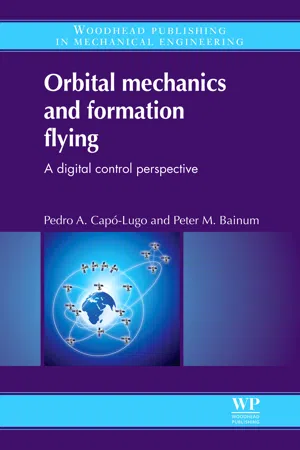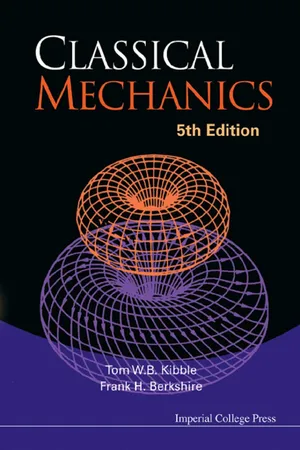Physics
Rigid Body Rotation
Rigid body rotation refers to the motion of an object where every point in the body moves in a circular path around a fixed axis. In this type of rotation, the shape and size of the object remain constant. Rigid body rotation is characterized by the conservation of angular momentum and the application of torque to produce rotational motion.
Written by Perlego with AI-assistance
Related key terms
11 Key excerpts on "Rigid Body Rotation"
- eBook - ePub
- A. L. Stanford, J. M. Tanner(Authors)
- 2014(Publication Date)
- Academic Press(Publisher)
rigid body . Rigid bodies are an idealization—they don’t exist in any state—but actual bodies can flex. We use the notion of a rigid body to facilitate the analysis of the motion of actual physical bodies. In the analysis of many physical bodies, the rigid-body assumption is an excellent approximation. In this chapter we will assume that all extended bodies are rigid bodies.Let us now consider the description of the purely rotational motion of a rigid body turning about an axis fixed in space.Rotational Kinematics
Consider the circular disk of Figure 7.1(a) . It is a rigid body attached to a rod lying along an axis passing through the center of the disk normal to the face of the disk. An axis of rotation of a body is a line in space about which the particles within the body maintain a constant distance and, therefore, move in a circular path about the axis. Because the disk is a rigid body, the rotational motion of the disk may be described by the motion of an arbitrary particle within the disk. Look, then, at the particle P on the face of the disk shown in Figure 7.1(b) . We will now define the variables that specify the rotational motion of the disk.Figure 7.1 A rigid circular disk with a fixed axis of rotation passing through its center. The axis is perpendicular to the face of the disk.The angle θ, measured counterclockwise from a fixed reference line to a radial line through the point P , as shown in Figure 7.1 (b) , is the angular position of the particle at point P . The length s of the arc that lies at a distance r from the axis is related to θbys = r θ(7-1)(7-1)when θis measured in radians . The rate at which s changes with respect to time is obtained by differentiating Equation (7-1) with respect to time. Recognizing that r is a constant, we obtain(7-2)= rd sd td θd t(7-2)In Equation (7-2) , ds /dt isvt, the tangential component of the instantaneous velocity of the particle, or(7-3)v td sd t(7-3)We define dθ/dt , the instantaneous time rate of change of angular position, to be the instantaneous angular velocity ω of P (and, therefore, of the disk), orω =(7-4)d θd t(7-4)The unit of angular velocity is radians per second (rad/s). Using the definitions of Equations (7-3) and (7-4) , we may write Equation (7-2) - eBook - ePub
- H. Harrison, T. Nettleton(Authors)
- 1997(Publication Date)
- Butterworth-Heinemann(Publisher)
4Rigid Body Motion in Three Dimensions
4.1 Introduction
A rigid body is an idealization of a solid object for which no change in volume or shape is permissible. This means that the separation between any two particles of the body remains constant.If we know the positions of three non-colinear points, i, j and k , then the position of the body in space is defined. However, there are three equations of constraint of the form |ri −rj| = constant so the number of degrees of freedom is 3 × 3 − 3 = 6.4.2 Rotation
If the line joining any two points changes its orientation in space then the body has suffered a rotation. If no rotation is taking place then all particles will be moving along parallel paths. If the paths are straight then the motion is described as rectilinear translation and if not the motion is curvilinear translation. From the definitions it is clear that a body can move along a circular path but there need be no rotation of the body.It follows that for any pure translational motion there is no relative motion between individual particles. Conversely any relative motion must be due to some rotation.The rotation of a rigid body can be described in terms of the motion of points on a sphere of radius a centred on some arbitrary reference point, say i . The body, shown in Fig. 4.1 , is now reorientated so that the points j and k are moved, by any means, to positions j′ and k′ . The arc of the great circle joining j and k will be the same length as the arc joining j′ and k′, by definition of a rigid body. Next we construct the great circle through points j and j′ and another through the points k and k′ . We now draw great circles which are the perpendicular bisectors of arcs jj′ and kk′ . These two circles intersect at point N. The figure is now completed by drawing the four great circles through N and the points j, k, j′ and k′ respectively.Fig. 4.1By the definition of the perpendicular bisector arc Nj = arc Nj′ and arc Nk = arc Nk′ . Also arc jk = arc j′k′ and thus it follows that the spherical triangle k Nj is congruent with k′ Nj′ . Now the angle k Nj = k′ Nj′ and the angle k Nj′ is common; therefore angle k Nk′ = j Nj′ - eBook - ePub
Newtonian Dynamics
An Introduction
- Richard Fitzpatrick(Author)
- 2021(Publication Date)
- CRC Press(Publisher)
CHAPTER 8 Rotational MotionDOI: 10.1201/9781003198642-88.1 Introduction
Up to now, we have only analyzed the dynamics of point masses (i.e., objects whose spatial extent is either negligible, or plays no role in their motion). Let us now broaden our approach in order to take extended objects into account. The only type of motion that a point mass object can exhibit is translational motion; that is, motion by which the object moves from one point in space to another. However, an extended object can exhibit another, quite distinct, type of motion by which it remains located (more or less) at the same spatial position, but constantly changes its orientation with respect to other fixed points in space. This new type of motion is called rotation. Let us investigate rotational motion.8.2 Rigid Body Rotation
Consider a rigid body executing pure rotational motion (i.e., rotational motion that has no translational component). It is possible to define an axis of rotation (which, for the sake of simplicity, is assumed to pass through the body); this axis corresponds to the straight-line that is the locus of all points inside the body that remain stationary as the body rotates. A general point located inside the body executes circular motion that is centered on the rotation axis, and orientated in the plane perpendicular to this axis. In the following, we shall tacitly assume that the axis of rotation remains fixed.Figure 8.1 shows a typical rigidly rotating body. The axis of rotation is the line AB. A general point, P, lying within the body executes a circular orbit, centered on AB, in the plane perpendicular to AB. Let the line QP be a radius of this orbit that links the axis of rotation to the instantaneous position of P at time t. Obviously, this implies that QP is normal to AB. Suppose that at timet + δ tpoint P has moved to P′ , and the radius QP has rotated through an angleδ ϕ. The instantaneous angular velocity of the body,ω ( t ) - eBook - ePub
General Physics
Mechanics and Molecular Physics
- L D Landau(Author)
- 2013(Publication Date)
- Pergamon(Publisher)
CHAPTER IIIMOTION OF A RIGID BODY
Publisher Summary
This chapter discusses some types of motion of a rigid body. In mechanics, rigid body means that the relative position of the parts of a body remains unchanged during the motion. The body, thus, moves as a whole. The simplest motion of a rigid body is one in which it moves parallel to itself; this is called translation. For example, if a compass is moved smoothly in a horizontal plane, the needle will retain a steady north-south direction and will execute a translational motion. In translational motion of a rigid body, every point in it has the same velocity and describes a path of the same shape, there being merely a displacement between the paths. Another simple type of motion of a rigid body is rotation about an axis. The chapter describes the energy of a rigid body in motion, rotational angular momentum, gyroscope, and inertia forces.§25. Types of motion of a rigid body
So far we have considered the motion of bodies which might be regarded as particles under certain conditions. Let us now go on to consider motions in which the finite size of bodies is important. Such bodies will be assumed to be rigid . In mechanics, this term means that the relative position of the parts of a body remains unchanged during the motion. The body thus moves as a whole.The simplest motion of a rigid body is one in which it moves parallel to itself; this is called translation . For example, if a compass is moved smoothly in a horizontal plane, the needle will retain a steady north-south direction and will execute a translational motion.In translational motion of a rigid body, every point in it has the same velocity and describes a path of the same shape, there being merely a displacement between the paths.Another simple type of motion of a rigid body is rotation about an axis. In rotation, the various points in the body describe circles in planes perpendicular to the axis of rotation. If in a time dt the body rotates through an angle dφ , the path ds traversed in that time by any point P of the body is clearly ds = r dφ , where r is the distance of P from the axis of rotation. Dividing by dt , we obtain the velocity of P - eBook - ePub
- Michael M. Mansfield, Colm O'Sullivan(Authors)
- 2020(Publication Date)
- Wiley(Publisher)
7 Rigid body dynamicsAIMS
- To show how the principles governing the motion of many‐body systems, discussed in the previous chapter, can be applied to the motion of rigid bodies
- To develop a formalism for the treatment of the motion of a rigid body about a fixed axis
- To outline the formal equivalence between the principles which determine the motion of rigid bodies about a fixed axis and those which determine the motion of a point particle, as discussed in earlier chapters
- To consider the more complicated situation where the axis of rotation is not fixed, as in the case of gyroscopic motion
7.1 Rigid bodies
A rigid body is a many‐body system in which the distance between each pair of particles remains fixed, that is, the system keeps its shape despite the action of any external forces. The motion of such a system under the influence of a net external forceFEXTand of a net momentMEXTis determined by the Equations (6.5) and (6.25) which were derived in the previous chapter, namely(7.1)and(7.2)In Equation (7.1) P is the total momentum which is related toVC, the velocity of the centre of mass of the rigid body, by Equation (6.16) and hence, from Equation (6.17) ,(7.3)where ℳ is the mass of the body. Note that, in this and in some subsequent sections, the symbol ℳ is used for the mass of a body to avoid any possible confusion with the symbol for moment (M).As an example of a rigid body, consider a body of arbitrary shape, as illustrated in Figure 7.1 , which can be thought of as comprising a large number of particles of massesm1 , m2 , m3 ,… etc. If all of the body is near the Earth's surface so that g is effectively constant over its extent, then each component mass miof a body near the Earth's surface experiences a forcem. In the absence of any other external forces, the net external force on the body is given by , where is the mass of the body. The net external moment, relative to the origin O, is given byig - eBook - ePub
Classical Mechanics
A Computational Approach with Examples Using Mathematica and Python
- Christopher W. Kulp, Vasilis Pagonis(Authors)
- 2020(Publication Date)
- CRC Press(Publisher)
CHAPTER 11Rigid Body MotionWe begin this chapter by reviewing the rotational motion of a single particle around an arbitrary axis, and the concepts of the moment of inertia and the center of mass. In particular we focus on how the center of mass simplifies the description of the translational and rotational motion of a system of particles. After the review, we explore generalized definitions of the moment of inertia, including products of inertia and the inertia tensor, and we demonstrate how to calculate these quantities for a variety of solids. We will see that the moment of inertia tensor of a solid depends on the choice of the coordinate system. Furthermore, we will discuss the parallel axis theorem for rigid bodies and show how it can be used to calculate the moment of inertia tensor. This is followed by a discussion of eigenvalues and eigenvectors of matrices, and how they can be used to describe the principal axes of a rigid body. The chapter will conclude with a discussion of the Euler equations and how they can be used to describe the precessional motion of spinning tops and gyroscopes.11.1Rotational motion of particles around a fixed axisIn this section, we will review rotational motion concepts that you likely learned in your introductory physics course. Here we will focus on the rotational motion of a particle that is confined to move in a circle of radius r in the xy-plane with an angular velocityω =, as illustrated in Figure 11.1ω zk ^ - eBook - ePub
Applied Engineering Mechanics
Statics and Dynamics
- C. Poll, G. Boothroyd(Authors)
- 2018(Publication Date)
- Routledge(Publisher)
17 Dynamics of Rigid Bodies 17.1 IntroductionIn the previous three chapters, the motion of particles due to the application of external forces was studied. There, each body was assumed to be either infinitesimally small so that its mass and all the external forces acting were concentrated at the same point, or the orientation of the body in space was unimportant so that it was not necessary to take into account the body’s shape or the exact location of the forces. In this chapter, we shall be concerned with a study of the relationships between the forces that act on any rigid body and the corresponding translational and rotational motions of the body.Only two equations of motion are needed to determine either the planar motion of a single particle or the planar motion of the center of mass of a group of particles. For the planar motion of a rigid body, an additional equation of motion is needed in order to determine the rotational motion of the body.17.2 Planar Motion of a Rigid BodyFigure 17.1a shows the free-body diagram for a rigid body moving in the xy plane. Since a rigid body is merely a collection of particles with no relative linear motion between them, the motion of the center of mass of the body can be determined from the translational equations of motion in the x and y directions as follows:Fig. 17.1 Rigid body with planar motion.F x= ma= mc xx ¨c(17.1) F y= ma= mc yy ¨c(17.2) where m is the total mass of the body; Fx and Fy are the sums of the components of the external forces in the x and y direction, respectively; and acx and acy are the components of the acceleration of the center of mass in these two directions, respectively.To develop the rotational equation of motion, we can examine first the motion of a single particle of mass mp located at P (Fig. 17.1b ). This motion consists of the rotation of point P about the center of mass C superimposed on the motion of the center of mass. Thus, the total inertia forces for the particle will be the sum of the individual inertia force components shown in the two diagrams in Fig. 17.1b . Now if Fex and Fix represent the x components of the external and internal forces acting on the particle, respectively, and Fey , Fiy represent the y components, the free-body diagram for the particle will be as shown in Fig. 17.1c . Taking moments about C and equating the moments of the forces in Fig. 17.1c to the sum of the moments of all the individual inertia forces in Fig. 17.1b - eBook - ePub
- Britannica Educational Publishing, Erik Gregersen(Authors)
- 2010(Publication Date)
- Britannica Educational Publishing(Publisher)
i = 1, 2, 3 …:In a rigid body, the quantity in parentheses in equation (76) is always constant (each bit of massmialways remains the same distanceRifrom the axis). Thus if the motion is accelerated, thenRotation around a fixed axis . Copyright Encyclopædia Britannica; rendering for this edition by Rosen Educational ServicesRecalling that τ = dL/dt , one may write(These equations may be written in scalar form, since L and τ are always directed along the axis of rotation in this discussion.) Comparing equations (76) and (78) with (74) and (75), one finds thatThe quantity I is called the moment of inertia.According to equation (79), the effect of a bit of mass on the moment of inertia depends on its distance from the axis. Because of the factor , mass far from the axis makes a bigger contribution than mass close to the axis. It is important to note thatRiis the distance from the axis, not from a point. Thus, ifxiandyiare the x and y coordinates of the massmi, then , regardless of the value of the z coordinate.The moment of inertia of any body depends on the axis of rotation. Depending on the symmetry of the body, there may be as many as three different moments of inertia about mutually perpendicular axes passing through the centre of mass. If the axis does not pass through the centre of mass, the moment of inertia may be related to that about a parallel axis that does so. LetIcbe the moment of inertia about the parallel axis through the centre of mass, r the distance between the two axes, and M - eBook - ePub
Orbital Mechanics and Formation Flying
A Digital Control Perspective
- P A Capó-Lugo, P M Bainum(Authors)
- 2011(Publication Date)
- Woodhead Publishing(Publisher)
5Rigid body motion
Abstract:
The rotational motion of a body about its center of mass is called attitude dynamics. This chapter highlights the formulation for the development of the attitude dynamics equations of motion. First, the torques associated with the motion of a single particle and a system of particles are explained. Second, a description of the moments of inertia is explained such that it can be used for the development of the rotational equations of motion. Third, the equations of motion are explained in terms of the angular momentum, Lagrange’s equations, and the quasi-coordinates system. Also the kinematic equations associated with quaternions are explained. Finally, the translational and rotational equations of motion are determined for the Ares V rocket as an example.Key words rate of change of a vector torques angular momentum moments of inertia principal moments of inertia kinematics equations for a quaternion Ares V translational and rotational equations of motion rotational Lagrange’s equations Lagrange’s equations for quasi-coordinates5.1 Introduction to attitude dynamics
In Chapter 4 , the rotation of a body about a reference axis is explained and developed. As a continuation, the objective of this chapter is to explain the motion of a rotating body when there are surface forces acting on the body. The surface forces acting on a rotational body about a reference point are known as torques. Mathematically, the torques are referred to as the cross product between the distance from a reference point to the applied force. In Section 5.2 , the rate of change of a vector is determined and is used to explain the applied torques on an arbitrary body. Then, the time derivative is expanded to define the translational and rotational motion of a body.When the J2 perturbation is explained in Chapter 3 , the moments of inertia are introduced but not defined. In Section 5.3 , a formal definition of the moments of inertia is explained in terms of the angular momentum of a body. The moments of inertia express the rotation of a body about its own axis. The moments of inertia are analogous to the constant mass in Newton’s Second Law of Motion and can be written in a matrix called the inertia matrix. In Section 5.4 - eBook - ePub
- Tom W B Kibble, Frank H Berkshire(Authors)
- 2004(Publication Date)
- ICP(Publisher)
Chapter 9Rigid BodiesThe principal characteristic of a solid body is its rigidity. Under normal circumstances, its size and shape vary only slightly under stress, changes in temperature, and the like. Thus it is natural to consider the idealization of a perfectly rigid body, whose size and shape are permanently fixed. Such a body may be characterized by the requirement that the distance between any two points of the body remains fixed. In this chapter, we shall be concerned with the mechanics of rigid bodies.9.1Basic PrinciplesIt will be convenient to simplify the notation of the previous chapter by omitting the particle label i from sums over all particles in the rigid body. Thus, for example, we shall writein place of (8.3) and (8.11). The motion of the centre of mass of the body is completely specified by (8.6):Our main interest in this chapter will be centred on the rotational motion of the rigid body. For the moment, let us assume, as we originally did in §8.3 , that the internal forces are central. Then, according to (8.14),We shall see later that these two equations are sufficient to determine the motion completely.One very important application of (9.1) and (9.2) should be noted. For a rigid body at rest, = 0 for every particle, and thus both P and J vanish. Clearly, the body can remain at rest only if the right hand sides of both (9.1) and (9.2) vanish, i.e., if the sum of the forces and the sum of their moments are both zero. In fact, as we shall see, this is not only a necessary, but also a sufficient, condition for equilibrium.Under the same assumption of central internal forces, we saw in §8.5 that the internal forces do no work, so thatThis might at first sight appear to be a third independent equation. However, we shall see later that it is actually a consequence of the other two. It is of course particularly useful in the case when the external forces are conservative, since it then leads to the conservation law - eBook - ePub
Stress, Strain, and Structural Dynamics
An Interactive Handbook of Formulas, Solutions, and MATLAB Toolboxes
- Bingen Yang(Author)
- 2005(Publication Date)
- Academic Press(Publisher)
9.130 ).The work-energy principle for a rigid body in three-dimensional motion is(9.145)where W 12 is the work done by the external forces acting on the body. If all the external forces are conservative, the mechanical energy of the body remains constant, namely,(9.146)where V is the potential energy of the body. The linear momentum and angular momentum of a rigid body have been studied in Section 9.3.3 . The impulse-momentum principles for three-dimensional motion have similar forms as those for plane motion. The linear impulse-momentum equation for a rigid body is(9.147)The angular impulse-momentum equation for a rigid body is(9.148)where A is either the mass center G of the body or a fixed point about which the body rotates.9.4.4 Equations of Motion
Fundamental Equations The motion of a rigid body in three dimensions can be described by the force equation(9.149)and the moment equation(9.150)where Σ F is the resultant force, m is the mass of the body, a G is the acceleration of the mass center G , Σ M G is the resultant moment about G , and H G is the angular momentum of the body about G . If a rigid body rotates about a fixed point O , its motion can be described by(9.151)where Σ M O is the resultant moment about O , and H O is the angular momentum of the body about O .Moment Equation in a Rotating Frame
In many problems, it is convenient to describe the angular momentum of a rigid body in a moving frame. Consider a rotating frame Axyz with angular velocity ω in Fig. 9.4.10 , where A is either the mass center of the body or a fixed point. Let the angular velocity of the body be ω. The rate of change of H A , according to Eq. (9.114) , is(9.152)Thus, the moment equation of the rigid body associated with the rotating frame is(9.153)Moment Equation in a Body Frame
If the moving frame Axyz in Fig. 9.4.10 is attached to the body such that Ω = ω, the frame is called a body frame . The moment equation associated with the body frame, by Eq. (9.153)
Index pages curate the most relevant extracts from our library of academic textbooks. They’ve been created using an in-house natural language model (NLM), each adding context and meaning to key research topics.

